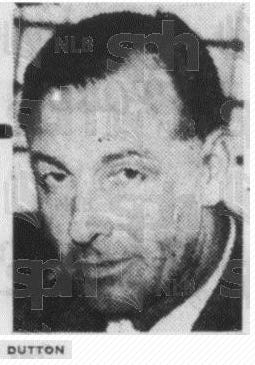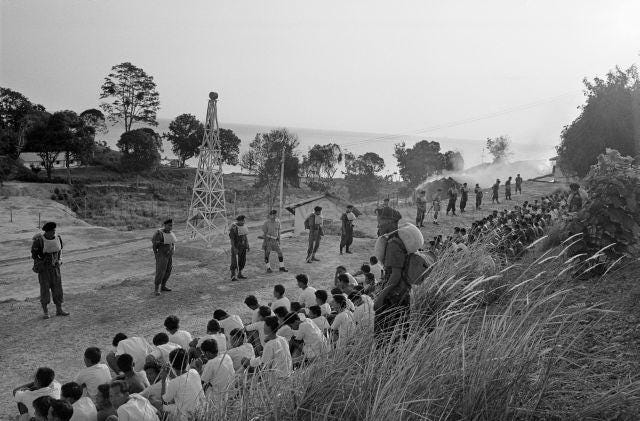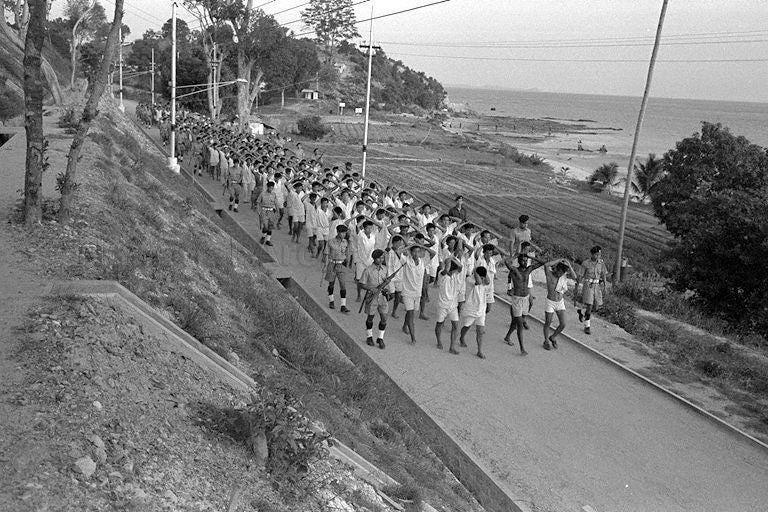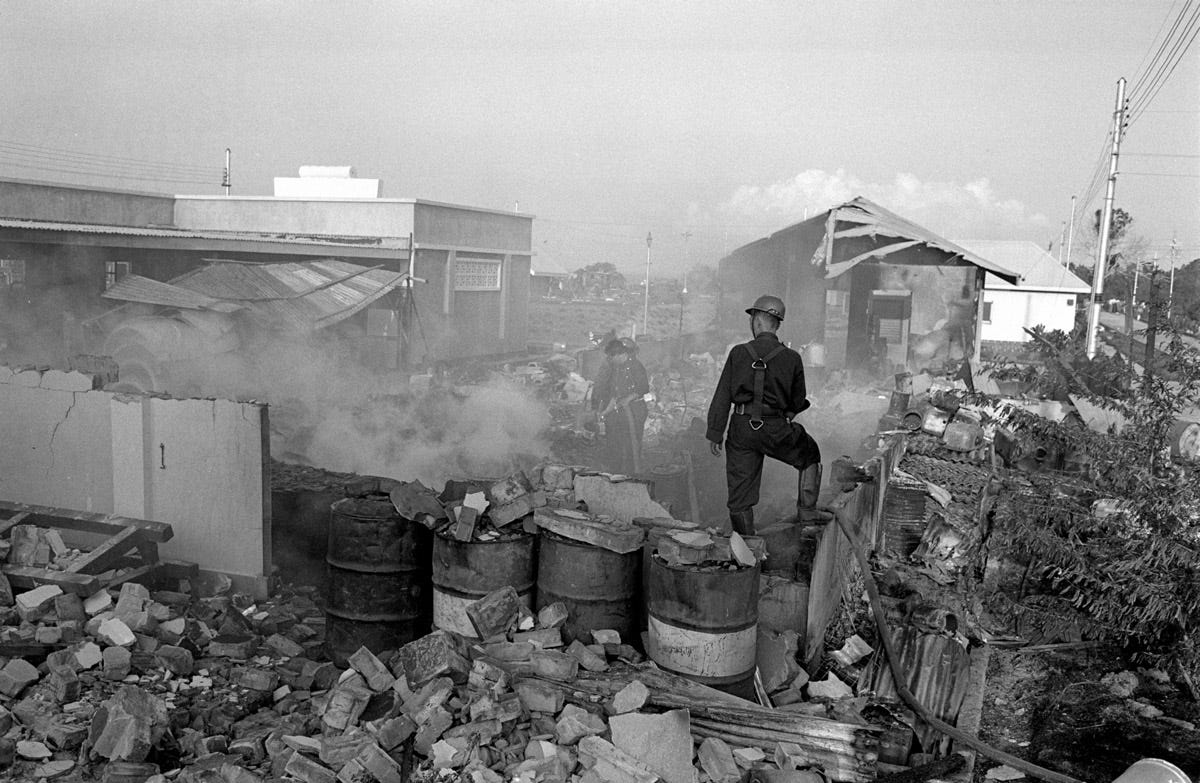No preamble. This is a longer piece and I hope you’ll take the time to digest it all! It’s a little known story from the 60s that I’ve cobbled together through various archival documents. I wish I could fit everything I learned - all the names, statements, grieving - in one newsletter.
But hopefully, this’ll do.
The Pulau Senang Riots
“Here is no Devil’s Island or Alcatraz, but living proof of the value of free and creative labour in pleasant surroundings as the means of rehabilitation of hardened offenders against society.”
So goes an article from The Straits Times on September 29th, 1962. Less than a year before a prison riot led to the murders of Superintendent Daniel Dutton, and Officers Arumugan Veerasingham and Tan Kok Hian.
In 1960, Singapore was basking in its newfound autonomy within the British Empire. Anti-imperial sentiment had been growing since the 40s, when the British surrendered Singapore to Japan. After World War II, the British returned and wisely began to transfer their powers back to the Singaporean people.

It was with this backdrop that the Irish-born Daniel Dutton was placed in charge of Pulau Senang. He envisioned turning the island’s “virgin jungle” into a penal colony that would rehabilitate gang members. Dutton’s plan was to set detainees to hard labor and, after some months, recommend the best workers for release.
Within three years, the island became a livable settlement, releasing over 200 of those detained. But on July 12th, 1963, Pulau Senang was “almost wholly destroyed in less than 40 minutes.” Dutton was set on fire and mutilated.
71 men went on trial. Each of them wore number tags around their neck for easy identification, and each were asked through a translator if they wished to be represented as a group or individually. All chose individually. (Read the charges here.)
18 were given the death penalty. Singapore’s first Chief Minister (aka Prime Minister) David Marshall was actually the lawyer who fought against the judgement, but he lost every single appeal.

Pulau Senang in 1961, courtesy of the National Archives of Singapore.
So what happened?
Pulau Senang’s Superintendent Daniel Dutton was a hard worker with a laser-focus on the success of the island. In his determination to build infrastructure as quickly as possible, he expected detainees to adhere to an unsustainable pace. In 1961, Dutton’s superior on the mainland wrote to him: “I thought we had reached a stage when people should not be working all day.” Over the next two years, Dutton defied multiple requests to stick to a 44 hour work week.
Tensions reached a breaking point when Dutton petulantly sent 13 carpenters back to prison, after they refused to build a jetty on their day off.
Rumors of a “death list” spread amongst the detainees in the next two days. Dutton wasn’t entirely loathed, and Hoe Hock Hai (Accused No. 11 in court) spoke privately to him, warning of the plot. Dutton “loudly laughed it off.” Even on the day of the incident, he didn’t consider leaving the island. He radioed his superiors to say so: “Good God, there is no need for that. There are always so many among them who will stand by me.” And they might have. Dutton reportedly told his staff to arm the non-rioting detainees, but his suggestion was shot down.

Post-riot, detainees assembled by wardens. Courtesy of the National Archives of Singapore.
At about 1PM that day, staff heard calls to riot. Wee Eng Cheng watched 10 detainees approach the administrator’s block - carrying axes, iron pipes, and other assorted weapons. Dutton and a group of employees tried to fight off the rioters. Some of the mob even began to attack detainees who refused to take part, and the staff encouraged them to hide in the jungle. Dutton was chased out of the administrative building after it was set on fire and three rioters rushed to attack him. 30 more followed. His body was left charred just outside the radio room.
The story was a shock to the general public. As far as they knew, Dutton’s experiment in rehabilitation had been a success. The rioters’ defense attorneys alleged otherwise.
A clarification - none of the detainees were convicts. They were held under the Temporary Provisions Ordinance because of their connections with secret societies. During cross-examinations, some of the men were indeed accused of being high-ranking gang members. But there was no specific penance in their labour - only knowledge that if they were sent back to Changi Prison, there was an even smaller likelihood of release.
Numerous detainees would also testify to Dutton’s grueling demands.
Lim Teck San, Accused No. 21: “Are you aware that prisoners are not provided with raincoats and have to work in the rain while officers have raincoats?” The response: “The prison budget has not reached such a level yet.” Another member of the accused testified that some detainees were “not given a drop of water” even when made to work at night. And all this to create what the defense referred to as “a showpiece of the world.” Illustrative of the argument: during the early months of the colony, Dutton brought visitors to the island, bragging about how the detainees built “a $1,200 speedboat for $150.”

Detainees leaving the island, accompanied by wardens. Courtesy of the National Archives of Singapore.
There were other witnesses who insisted that Dutton was kind-hearted, fair, and not a “slave-driver” by any means. But it wasn’t just a question of Dutton’s leadership. It had become clear to the detainees that some of them were never getting off the island.
Lim Kim Sian, Accused No. 45: “I was on Pulau Senang for 28 months. My conduct sheet was good. Why was I not released?” Response: “[I can] only imagine that [your] secret society record might be appalling in its magnitude.” Lim was then told that they could not check records, because they had been burned in the riots.
The detainee who mentioned dehydration also stated that his peers “had been released not through hard work but bribery.” In a cross-examination of Dutton’s superior: “A man’s name might appear six or seven times on the [recommended release] list, but there might be police objections to such release.”
A witness who tried to help Dutton stated that although “Mr. Dutton was not corrupt” other staff took money from relatives of detainees, claiming they would recommend their family member’s release. Tensions were likely not helped by the fact that some of the imprisoned were supervised by members of rival gangs.

The aftermath of the riots, courtesy of the National Archives of Singapore.
The defense boiled it all down to this: “Human emotions … are like the springs of a watch. If the watch is properly wound, it will serve well. If it is not handled with care, it requires repairs. But if it is given the final twist - it becomes irreparable.”
Rioters were reported to have sang as the island burned. “They had cakes and drinks,” a witness confirmed, and strutted about “like conquerors of Pulau Senang.” Interesting wording when 11 days after that exact testimony, the Crown colony was dissolved - ending 144 years of British rule over Singapore.
In his final moments, Dutton pleaded to his murderers: “If you were to help me, I would recommend your early release.” The response: “It’s too late for us to help you.”
Post-Amble: Ripped From the Headlines
🎰 This week in Cambodia, officials shut down a casino, responding to complaints about pollution, illegal betting, and security shooting bullets into the sky.
💰 This month in Singapore, an 18-year-old was arrested for scamming people who just wanted to buy BTS merch. It’s a bad week to be K-pop adjacent, because…
🎵 Ongoing in South Korea, a K-pop star is under investigation for filming/sharing sex tapes without consent. Multiple other idols are alleged to have viewed the tapes.
🚔 Last year in China, a cop pretended to be hit by a car so he could extort money from the driver.
🚨 Bonus crime! CIA agents broke into the North Korean Embassy in Madrid, tying up and gagging staff, threatening them with plastic guns, stealing dossiers, and making off with computers. 🚨 Cool.


